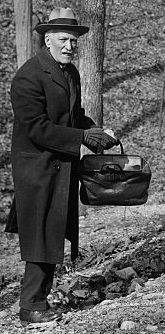Walter Hough: Difference between revisions
Cloud atlas (talk | contribs) adding a source and some facts |
Cloud atlas (talk | contribs) adding infobox |
||
| Line 1: | Line 1: | ||
{{Refimprove|auto=yes|date=December 2009}} |
{{Refimprove|auto=yes|date=December 2009}}'''Walter Hough, Ph.D.''' (1859–1935) was an American [[ethnologist]] who worked for the [[Smithsonian Institution]]. |
||
{{Infobox scientist |
|||
[[File:PSM V66 D392 Walter Hough.png|thumb|Walter Hough, ''Popular Science Monthly'', 1904-1905]] |
|||
| name = Walter Hough |
|||
'''Walter Hough, Ph.D.''' (1859–1935) was an American [[ethnologist]] who worked for the [[Smithsonian Institution]]. |
|||
| image = PSM V66 D392 Walter Hough.png |
|||
| caption = Walter Hough in 1904 |
|||
| image_size = |
|||
| birth_date = 1859 |
|||
| birth_place = [[Morgantown, West Virginia]], United States |
|||
| death_date = 1935, aged approx. 76 |
|||
| death_place = |
|||
| citizenship = American |
|||
| residence = [[Washington, D.C.]] |
|||
| work_institutions = [[Smithsonian Institution]] |
|||
| alma_mater = [[West Virginia Agricultural College]], and [[West Virginia University]] |
|||
| known_for = |
|||
| awards = [[Order of Isabella the Catholic|Order of Isabella]] |
|||
| influences = |
|||
| influenced = [[Paul Sidney Martin]] |
|||
| signature = |
|||
}} |
|||
==Life== |
==Life== |
||
Hough was born at [[Morgantown, West Virginia]]. He was educated at [[Monongalia Academy]], [[West Virginia Agricultural College]], and [[West Virginia University]] (A.B., 1883; Ph.D., 1894). He was employed at the [[National Museum of Natural History|Smithsonian National Museum of Natural History]] as an assistant (1886–94), as assistant [[curator]] of ethnology (1896–1910), and as curator from 1910 until his death in 1935. Though Hough's work revolved around cataloging the museum's collections, he also spent time doing [[Archaeology|archaeological]] field work in the [[Southwestern United States|American Southwest]]. In 1905, Hough unearthed preserved cobs of [[maize]] in a cave in [[New Mexico]] that helped subsequent archaeologists determine that the [[Mogollon culture|Mogollon ethnic group]] inhabited the area before the [[Ancestral Puebloans|Anasazi Puebloans]], who were previously considered to be the area's earliest inhabitants.<ref>{{Cite web|url=https://www.smithsonianmag.com/smithsonian-institution/ancient-maize-thousands-years-civilization-america-180970543/|title=What Ancient Maize Can Tell Us About Thousands of Years of Civilization in America|last=Mann|first=Charles C.|date=November 2018|website=Smithsonian Magazine|language=en|archive-url=|archive-date=|dead-url=|access-date=2018-12-19}}</ref> |
Hough was born at [[Morgantown, West Virginia]]. He was educated at [[Monongalia Academy]], [[West Virginia Agricultural College]], and [[West Virginia University]] (A.B., 1883; Ph.D., 1894). He was employed at the [[National Museum of Natural History|Smithsonian National Museum of Natural History]] as an assistant (1886–94), as assistant [[curator]] of ethnology (1896–1910), and as curator from 1910 until his death in 1935. Though Hough's work revolved around cataloging the museum's collections, he also spent time doing [[Archaeology|archaeological]] field work in the [[Southwestern United States|American Southwest]]. In 1905, Hough unearthed preserved cobs of [[maize]] in a cave in [[New Mexico]] that helped subsequent archaeologists determine that the [[Mogollon culture|Mogollon ethnic group]] inhabited the area before the [[Ancestral Puebloans|Anasazi Puebloans]], who were previously considered to be the area's earliest inhabitants.<ref>{{Cite web|url=https://www.smithsonianmag.com/smithsonian-institution/ancient-maize-thousands-years-civilization-america-180970543/|title=What Ancient Maize Can Tell Us About Thousands of Years of Civilization in America|last=Mann|first=Charles C.|date=November 2018|website=Smithsonian Magazine|language=en|archive-url=|archive-date=|dead-url=|access-date=2018-12-19}}</ref> |
||
Revision as of 06:46, 19 December 2018
This article needs additional citations for verification. (December 2009) |
Walter Hough, Ph.D. (1859–1935) was an American ethnologist who worked for the Smithsonian Institution.
Walter Hough | |
|---|---|
 Walter Hough in 1904 | |
| Born | 1859 Morgantown, West Virginia, United States |
| Died | 1935, aged approx. 76 |
| Citizenship | American |
| Alma mater | West Virginia Agricultural College, and West Virginia University |
| Awards | Order of Isabella |
| Scientific career | |
| Institutions | Smithsonian Institution |
Leben
Hough was born at Morgantown, West Virginia. He was educated at Monongalia Academy, West Virginia Agricultural College, and West Virginia University (A.B., 1883; Ph.D., 1894). He was employed at the Smithsonian National Museum of Natural History as an assistant (1886–94), as assistant curator of ethnology (1896–1910), and as curator from 1910 until his death in 1935. Though Hough's work revolved around cataloging the museum's collections, he also spent time doing archaeological field work in the American Southwest. In 1905, Hough unearthed preserved cobs of maize in a cave in New Mexico that helped subsequent archaeologists determine that the Mogollon ethnic group inhabited the area before the Anasazi Puebloans, who were previously considered to be the area's earliest inhabitants.[1]

In 1892, Hough was made Knight of the Order of Isabella when in Madrid as a member of the United States Commission. He was also a member of Dr. J. Walter Fewkes' expedition to Arizona (1896–97).
Publications
- "Censers and incense of Mexico and Central America"—full online copy at HathiTrust[2]
References
- ^ Mann, Charles C. (November 2018). "What Ancient Maize Can Tell Us About Thousands of Years of Civilization in America". Smithsonian Magazine. Retrieved 2018-12-19.
{{cite web}}: Cite has empty unknown parameter:|dead-url=(help) - ^ Hough, Walter (1912), "Censers and incense of Mexico and Central America", Proceedings of the United States National Museum, vol. 42, Washington: Smithsonian Institution Press (etc.) (published 7 April 1912), pp. 109–137, doi:10.5479/si.00963801.42-1887.109, ISSN 0096-3801, retrieved 16 April 2010
{{citation}}: Invalid|ref=harv(help)
External links
- "Walter Hough: An Appreciation", American Anthropologist, Volume 38, Issue 3,
- Christy G. Turner, II and Jacqueline A. Turner, "The First Claim for Cannibalism in the Southwest: Walter Hough's 1901 Discovery at Canyon Butte Ruin 3, Northeastern Arizona", American Antiquity, Vol. 57, No. 4 (Oct., 1992), pp. 661-682
